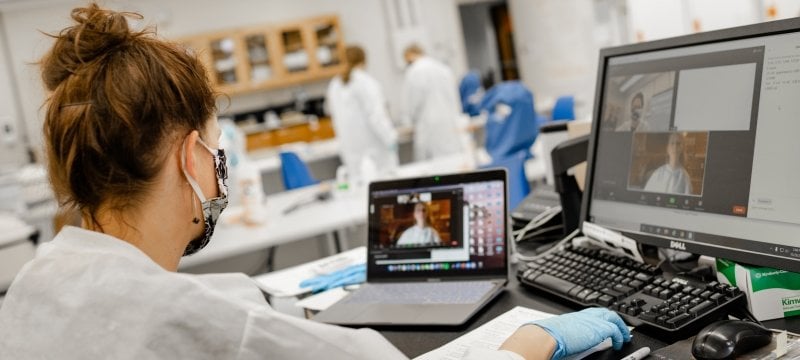The pandemic changed how we teach. Learning from outstanding instructors like Teaching Award winner Brigitte Morin offers hope and adaptability moving forward.
Morin is a senior lecturer in the Department of Biological Sciences recognized a number of times for her excellent teaching, including earning the Michigan Technological University Distinguished Teaching Award in 2018. Like most instructors, her classroom skills and formats are being put to the test.
About the Researcher
Morin is not going to tell you everything is OK. Nope. This is hard. This is messy. This is imperfect. We can’t change the reality of teaching, learning, studying and just trying to show up during a global pandemic. But to ignore the opportunities rooted in hardship is to pass up the chance to evolve, find more ease, connect with others and celebrate the small successes.
This Q&A is not prescriptive; it’s an exploration of ideas that might help. As Morin (BEM) puts it: “I don’t want to say, ‘It is what it, so deal.’ A lot is out of our control. What do I have the ability to change and make choices about right now?”
Q: Let’s define a few words first. What are some of the new terms you’re using to describe classes these days?
BEM: Remote means I am not in the room with my students. Synchronous means we are on a screen at the same time, doing live dialogues — they can ask questions and I can see their screens. Asynchronous means prerecorded lectures that students watch in their own time — they pace themselves, and I’m not there in real time. It comes down to technological limitations. I like interacting; that’s how I like to teach. But my largest course has 150 students, so there is no way I’m going to interact with that class on Zoom the same way I did in person.
Q: You have a simple system for adapting your remote courses based on class size. Could you explain that?
BEM: My large anatomy class is 150-plus, my nutrition course is about 75 students and the medical lab science (MLS) courses I teach are around 20. They all require different things.
In the spring, I knew that accommodating my biggest class wasn’t possible. The world was wild, there were so many students in the class, so an asynchronous format was a better option. I prerecorded lectures and I still kept them on a schedule with assignments, but personally I think going asynchronous saved me from tailoring the class for 150 students individually. I’m adapting the course to be remote synchronous next spring.
I also used a remote asynchronous format with my midsized classes. I thought to myself: I cannot accommodate all of them, so how do I do this? What is the shotgun approach that will work for 95% and then I work individually with other 5%? I did find that with the asynchronous format I lost touch with students and I don’t like that.
Pandemic Education Series
Classes are not running the way we’re used to. This series dives into educational endeavors folks are undertaking across campus to gather ideas, advice, hope, community and, yes, some commiseration, too.
It was easier with my MLS classes; however, these are students that I know well. I was able to do synchronous Zoom classes and they could work with me — we learned how to use breakout rooms together, they’d offer technical tidbits when I was struggling, we could talk in smaller groups. So, engagement was easier to do.
Q: Engagement is tough. What tools do you use?
BEM: In smaller classes, I ask my students to turn cameras on; there are pros and cons to having cameras on, but I appreciate it shows our reality. Makes it feel like we’re in it together instead of the illusion of being a prof on a stage giving a sanitized lecture.
I use iClickers, especially for big classes. I switched to their online platform and I wouldn’t switch back, honestly. With the online platform students have the ability to put in text answers and type in numerical values since the interface is on phone or computer. Students have told me that they have to really know this stuff when they answer — it’s not just a multiple-choice answer. I like that it deepens their learning. There are glitches but I really like it.
I also use a flipped classroom. Not that it was easy — far from it — but adapting a flipped classroom for remote instruction was easier than other teaching modes. It was slightly easier because students were already used to doing an online assignment and working with content before coming to class. Tough as it has been, the transition has encouraged me that my teaching style works.
Q: One of the classes you teach is called “Biology of Movement and Meditation,” so any mindful words of advice?
BEM: I’m stressed, students are stressed, everybody is stressed. We know what this does to our bodies and minds. So be patient. Be kind. If you show other people grace, they will show you grace.
For example, I tried adapting a lesson I normally do in person with students using sticky notes, and I was like, ‘Hey, there are virtual sticky notes, maybe I can make this work.’ It was awful. And halfway through I had to admit it wasn’t working. But because of the relationship and trust I have built with my students, we were able to work through it. Likewise, when they tell me about a problem they’re having with an assignment, I try to extend the same nonjudgment, and focus on coming up with a solution.
Q: Perfectionism drives a lot of hard work in academia. How do you let go of judgment?
BEM: It’s not an excuse to get out of things, it’s softening into and accepting our reality so that we can adapt and move forward with as much ease as possible.
Our health is our priority and we have to have boundaries. I’m saying it like I do it, but I don’t. (deep breath) Stop working. Take a weekend. Ignore that email; answer during your work hours. It’s crucial for the brain to go from work mode to rest mode. As an instructor, you want to help students — you want to answer that query at 7 p.m. So, here’s the nonjudgment piece: It’s about choosing not to and then not dwelling. I stop work at 5 p.m.; I have to believe that my life is going to be OK. Reframing and setting boundaries takes deliberate effort — who has extra effort these days? Probably no one, so extend that understanding to other people. Everything needs soften.
I don’t want to say, ‘It is what it is, so deal.’ A lot is out of our control. What do I have the ability to change and make choices about right now? We have to let go of what we can’t control. Nobody gets to rest on their laurels, and it’s not about sucking it up and dealing — it’s acceptance. I’m teaching online in the spring, so it’s a question of how. What is the best I can do with the resources I have?
Michigan Technological University is an R1 public research university founded in 1885 in Houghton, and is home to nearly 7,500 students from more than 60 countries around the world. Consistently ranked among the best universities in the country for return on investment, Michigan's flagship technological university offers more than 120 undergraduate and graduate degree programs in science and technology, engineering, computing, forestry, business, health professions, humanities, mathematics, social sciences, and the arts. The rural campus is situated just miles from Lake Superior in Michigan's Upper Peninsula, offering year-round opportunities for outdoor adventure.







Comments